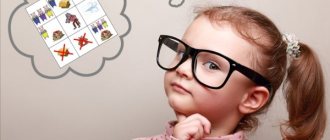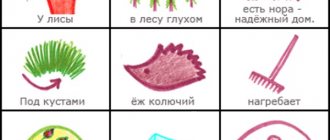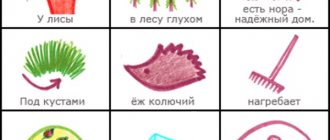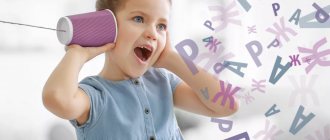What is mnemonics
Mnemonics are aimed at developing and improving memorization skills. The system of methods and exercises used in it allows a person not only to memorize the necessary material faster and more efficiently, but also to reproduce it. Mnemonics are becoming increasingly popular and are used when working with people of different ages.
It affects not only memory, but also the development of coherent speech. It is based on visual perception of the material and its further reproduction using pictures. The essence of working with a mnemonic table is simple: the child forms an associative connection between a certain word/phrase and an image. Then the word is depicted schematically.
The student carefully studies the images shown, which further facilitates rapid memorization and reproduction of text information. And this has a beneficial effect on his speech development.
The essence of the technique
Modern children, due to their immersion in the world of computer technology and busy parents, have many speech problems:
- inability to use complex, long sentences in speech;
- lack of skill to formulate thoughts;
- poor vocabulary, use of non-literary vocabulary and abbreviations in speech;
- inability to formulate questions and answers;
- poor diction;
- inability to build statements and draw conclusions.
The use of mnemonics allows you to effectively correct these shortcomings and make children’s speech rich and beautiful. In addition, it helps the development of:
- auditory and visual memory;
- imagination;
- perseverance;
- interest in learning;
- visual perception;
- associative thinking;
- logical thinking;
- skills of analysis and synthesis.
In modern speech therapy, the use of mnemonics begins at the age of 4, sometimes even at the age of 3. At the same time, articulatory gymnastics techniques are also used to eliminate pronunciation defects (you can read about them here).
Mnemonics, or memorization techniques, is an integral system of methods that are aimed at maximizing memorization and reproduction of the materials being studied. It is based on visual perception and further reproduction of information using certain images (more about this here).
When compiling mnemonic tables for speech development, a corresponding picture is used for a specific word. By studying the images offered to him, the baby can easily remember and reproduce the desired text.
In this case, information is tied not only to the picture itself, but also to the sensations that are associated with it (color, size, taste, smell). All these sensations are combined into an associative series, creating complex connections between nerve cells, which contributes to the memorization and reproduction of information.
In other words, a mnemonic table is a specific, specific diagram that acts as a visual aid and conveys the necessary information.
Advantages of mnemonic tables
The use of this table greatly simplifies the learning process, which is why it is very popular among teachers, including speech therapists. Mnemonics significantly accelerates the development of coherent speech in preschoolers. It contains bright pictures that simplify the learning process for a preschooler.
Bright, clear diagrams help master the skill of composing sentences and logical chains. In the future, it will be easier to compose texts with detailed descriptions and clarifying details. What are the main advantages of using mnemonic tables in the classroom?
- Development of visual and auditory memory.
- It is easier for a child to learn poems, retell given texts (especially fiction), and solve logical problems.
- Development of coherent speech, which also affects communication skills.
- Development of associative thinking.
The listed advantages make mnemonics increasingly in demand. Mnemonic tables are one of the main techniques in working with preschool children.
Mnemonic tables on speech development for older preschoolers
Correctly developed schemes are effective, not cumbersome, and resemble a game.
Speech Problems That Can Be Resolved Using Graphic Charts
Theme “Autumn” in the mnemonic table
Mnemonics solve speech problems:
- Difficulties in diction (including difficulty pronouncing sounds).
- Inability to control the voice (intonation, tempo, volume).
- Inability to build a dialogue (formulation of questions, detailed or short answers).
- Monosyllabic speech (includes only simple sentences).
- Insufficient vocabulary.
- Use of non-literary vocabulary.
- Difficulties during the construction of a monologue (retelling, descriptive or plot story on a specified topic).
- Inability to substantiate conclusions and conclusions.
Mnemonic table with children's hands
Thanks to the technique, the following mental and thought processes are improved, on which correct speech depends:
- memory;
- imagination;
- attention;
- observation;
- ability to compare and highlight key elements.
The essence of mnemonics
Mnemonics are used to develop the ability to remember, recreate information, and strengthen memory. The student perceives the material and reproduces it from the images. The essence of the technique: the baby develops associations between a word (phrase) and a picture. Next, the word is associated with a number of association pictures.
Important! Instead of drawings, symbols are suitable for adult preschoolers.
After mastering the method, the child is able to convey words (texts) schematically and decipher signs. Used by teachers, including speech therapists. This makes it easier to absorb knowledge. Tables are especially valuable when memorizing poetry, retelling texts, and solving logical problems. This is one of the basic techniques for the development of children in the DAO.
Advantages of technology
Mnemonic tables are attention-grabbing symbols and drawings that correspond to the mental characteristics of children (distracted attention, visual-figurative thinking). Advantages of the technique:
Colorful drawings are replaced by graphic symbols
- visualization of logical chains;
- emphasis on the essentials (main steps, historical moments, characteristics);
- availability of parts (for detailed descriptions);
- brightness, capacity, conciseness, holding attention;
- development of creativity, communication, associative thinking, speech.
Admission is in demand not only in DAO, but also in classes with students of any age.
Important! The gradual complication of tables and their diversity broadens one's horizons, improves imagination, and helps to systematize accumulated intellectual baggage.
Independent production of mnemonic tables
The material is purchased and created independently. It is worth taking Tkachenko T.A.’s schemes as a basis. or Vorobyova V.K. They are used as a starting point in creativity or modified, taking into account the individuality of the students. Stages of circuit development:
- Illustrations are selected for the word (draw, find ready-made ones). Bright, detailed pictures will suit kids.
- If the guys remember the drawing, it is replaced with a graphic symbol. For example, a bird is a tick, a squirrel is a brown circle.
- When retelling short works, children are guided by such schemes. These can be drawings, images and symbols, only symbols.
Setting the T sound
Didactic materials—illustrations—are indispensable when learning about colors, shapes, textures, and sizes. Separate pictures indicate parts of the encrypted item, areas of application, permitted and prohibited actions with it. Lessons with mnemonic tables begin with looking at pictures and talking (kids ask, guess, analyze).
Working with mnemonic tables in class
Methods of cognition using charts-tables
It is important to use the manual correctly in order to develop the necessary skills in children. Sequence of work:
- Examination of bright pictures indicating phrases and words.
- They study a more complex structure - mnemonic tracks (up to 4 consecutive, logically connected pictures). On their basis, the children compose short texts.
- Stage of formation of coherent texts. Thanks to pictures with actions (walking, swimming), verb vocabulary is learned. The emphasis is on the stages of action and their results.
While improving their speech, children try to notice important nuances of images without departing from the essence of the story.
Mnemonic tracks and tables fuel interest in studying the world, hold attention, and help find connections between objects.
Important! These visual diagrams are useful when studying literature, mathematics, nature and other subjects.
When to use mnemonic tables
This didactic material is most often used when working with children with learning difficulties. It is especially effective in classes with those who have speech problems. Mnemonic tables should definitely be used if:
- children's speech consists of simple sentences and phrases;
- it is difficult for a child to form logical chains;
- vocabulary lags behind the norm;
- difficulty formulating questions and answers;
- diction is broken.
Mnemonics allows you to eliminate these difficulties. At the same time, the child will be interested in the lesson, because he sees bright pictures.
Manufacturing technology
You can purchase ready-made teaching material. But mnemonic tables are easy to make yourself. In classes, ready-made options developed by V.K. Vorobyova or T.A. Tkachenko are most often used.
These mnemonic tables are taken as a basis and modified depending on the individual characteristics of the child.
You need to choose a word or phrase and an image that represents it. For children of primary and secondary preschool age, it is best to choose bright images - this will make it easier for the kids to remember the necessary material.
Then, when children learn the word and remember the picture, it can be replaced with a graphic symbol. For example, a squirrel - on a brown circle. With the help of such mnemonic tables, short fairy tales are retold: they can use both images and combine them with graphic symbols, or use graphic symbols entirely.
Such model schemes are used to study the characteristics of an object. Therefore, the main topics of classes using the didactic manual are the study of color, shape, size, texture of an object. The teacher can also ask the children what parts a particular object consists of, where it is used, what can be done with it and what cannot be done. Before asking questions, the child, together with an adult, carefully studies the mnemonic table.
Mnemonics in the speech development of preschool children
“Speech is a channel for the development of intelligence...
The sooner speech is acquired,
The easier and more complete the knowledge will be assimilated.”
V.A. Sukhomlinsky
Preschool education programs define one of the main objectives of the educational activities of preschool educational institutions as the task of children mastering speech as a means of communication and culture. Speech education of a preschool child includes enriching the active vocabulary, developing coherent, grammatically correct dialogical and monologue speech; development of speech creativity, sound and intonation culture of speech; acquaintance with book culture, children's literature, and much more. etc.
All these tasks must be implemented before the child enters school, since the psychophysiological capabilities of age create all the conditions for this.
However, it is no secret that nowadays figurative speech, rich in synonyms, additions and descriptions, in preschool children is a very rare phenomenon. In the process of speech development, the following problems are increasingly observed in children:
- inability to coordinate words in a sentence; monosyllabic speech consisting only of simple sentences; inability to speak grammatically correct;
- poverty of vocabulary;
- violation of sound pronunciation, poor diction.
- poor dialogical speech - the inability to formulate a question competently and clearly, to construct a short or detailed answer;
- inability to construct a monologue, for example, a plot or descriptive story on a proposed topic, retelling the text in your own words;
- lack of logical justification for one’s statements;
— lack of speech culture skills: inability to use intonation, regulate voice volume and speech rate, etc.;
- children do not know the techniques and methods of memorization. They are reluctant to learn poetry and retell texts. Memorizing poems causes them difficulties - rapid fatigue and negative emotions;
Therefore, kindergarten teachers were faced with the task of not only teaching children to express their thoughts coherently, consistently, and grammatically correctly, but, first of all, it was very important to awaken children’s interest in speech activity, captivate them, liberate them and turn backbreaking work into the most beloved and most accessible one. Kind of activity.
For this purpose, when teaching children, it is quite justified to use creative innovative methods and technologies, the effectiveness of which is obvious, along with generally accepted ones. Remembering the words of K. D. Ushinsky, who wrote: “Teach a child some five words unknown to him, he will suffer for a long time and in vain, but connect twenty such words with pictures, and he will learn them on the fly,” we decided to organize a search for such technology that will make it interesting for children and, at the same time, effectively develop their speech, and, therefore, contribute to their full mental development.
Such technology, in our opinion, is mnemonic technology, which facilitates memorization, increases memory capacity through the formation of additional associations and allows children to solve the problems of their speech development in a fun way. This is how T.B. presents it in his work. Polyanskaya [1].
L.V. Omelchenko defines mnemonics as a system of various techniques that facilitate memorization and increase memory capacity through the formation of additional associations, organizing the educational process in the form of a game. The purpose of teaching mnemonics is the development of memory, thinking, imagination, attention, which are closely related to the full development of speech [2].
In order to master mnemonics, teachers needed to get acquainted with the theory and technology of working with children, and understand the role of the teacher in this new direction of educational activity for us. For this purpose, the kindergarten held seminars and workshops, prepared and acquired the necessary methodological and didactic material.
We learned that the use of mnemonics is currently becoming relevant, since this pedagogical technology began its ascent in working with speech therapy children, whose speech development does not follow traditional methods. In addition, we studied the theoretical foundations of technology, methods of its application and diversity.
The main “secret” of the psychophysiological basis of mnemonics is very simple and well known. A person connects several visual images in his imagination, and the brain records this relationship. And later, when recalling one of the images of this association, the brain reproduces all previously connected images. It is well known that the language of the brain is images. And, above all, visual images. If we address the brain in its language, it will carry out any of our commands, for example, the “remember” command.
But where can we get programs that will allow us to communicate with the brain and encode the information we need into its figurative language? Mnemonics is such a program. It consists of several dozen mental operations, thanks to which it is possible to “establish contact” with the brain and take under conscious control some of its functions, in particular, the memory function.
The use of mnemonic techniques helps to increase memory capacity. All this is achieved through the formation of associations. Abstract objects and facts are replaced by images that have a visual, auditory or kinesthetic representation. Most children have difficulty remembering words with unknown, abstract meanings. Memorized information disappears from memory after a few days.
For durable and easy memorization, you should fill the word with content using mnemonic techniques. Connect it with specific bright visual and sound images, with strong sensations. The peculiarities of this technology lie in the use of symbols rather than images of objects. The technique of symbolization makes it much easier for children to find and memorize words. The symbols are as close as possible to the speech material. For example: a Christmas tree is used to designate wild animals, and a house is used to designate domestic animals.
Mnemonic technology helps in solving problems of speech development in the process:
- formation of skills and abilities of dialogical and monologue speech (examination of paintings, illustrations, conversations, conversation, composing stories, retelling fiction, etc.);
- activation and enrichment of vocabulary, including when guessing and making riddles. ;
- when memorizing poetry;
- formation of grammatically correct speech;
- teaching children to read and write.
Mnemonics promotes the development of mental processes in children such as: memory, logical thinking (the ability to analyze, systematize) and imaginative thinking.
With its help, various general educational and didactic tasks are solved: familiarization with various information; development of ingenuity, training of attention; teaching children the ability to establish cause-and-effect relationships in events and stories; fine motor skills develop. Children who master the means of mnemonics are subsequently able to independently develop speech in the process of communication and learning.
The effectiveness of using technology depends on certain conditions:
— the content of the material must be accessible to a child of a given age;
— use of various visual modeling techniques: pictograms, substitutes, mnemonic tables.
A pictogram is a symbolic image that replaces words; it is a picture with which you can write down words and expressions; it is a picture that will help you remember a given word. For example, a “merry holiday” - a ball, fireworks; a sign depicting a leg can mean walking, standing. Examples of pictograms - road signs, on clothing (clothing care)
You can use pictograms depicting: words-objects (for example, “girl”, “sun”, “butterfly”, etc.), words-signs (“big”, “small”, “sad”, “cheerful” etc.), action words (“goes”, “shines”, “flies”), prepositional symbols (“under”, “above”, “in”, etc.). The personal creativity of the teacher makes it possible to reproduce this in various variations.
Substitution is a type of modeling in which some objects are replaced by other, real-conditional ones. It is convenient to use paper squares, circles, ovals that differ in color and size as substitutes, because substitution is based on any difference between objects and their characteristics.
Acting out speech content with the help of substitutes, according to O.M. Dyachenko, it’s better to start with folk tales, because... stable stereotypes of familiar characters (orange fox, big and brown bear, etc.) are easily transferred to models. In the first lessons, the number of substitutes should match the number of characters, then you can introduce extra circles or squares so that the child can choose the ones he needs. At first, it is enough for the child to raise the corresponding symbol as the story is told to adults, then you can move on to acting out the story.
A special place in working with children is occupied by the use of such didactic material as mnemonic tables. A mnemonic table is a diagram that contains certain information. The content of a mnemonic table is a graphic or partially graphic representation of fairy tale characters, natural phenomena, some actions, etc. by highlighting the main semantic links of the story’s plot. The main thing is to convey a conventionally visual diagram, to depict it in such a way that what is drawn is understandable to children.
In a mnemonic table you can depict almost everything - a graphic or partially graphic representation of fairy tale characters, natural phenomena, some actions, i.e. You can draw whatever the teacher using this technology deems necessary. The main thing is to depict it in such a way that what is drawn is understandable to children.
Having studied the theoretical foundations, mastery of mnemonic technology began on the basis of the principle “from simple to complex”: at trainings and practical classes, teachers first became familiar with the technique of using the simplest mnemonic squares, successively moved on to mnemonic tracks and later to mnemonic tables.
Practical work with children began after an algorithm for working with the model was developed.
There are several stages in working with reference diagrams.
At the 1st stage, elements of diagrams and symbols were introduced. For example, designations of color, shape, size, action.
On the 2nd stage, they used elements of supporting schemes and symbols in all types of direct educational activities (hereinafter GCD) and in various types of children's activities. We were guided by the fact that the child should not get used to it, that this symbol is applicable only in one area, because the symbol is universal.
At the 3rd stage, the method of contradiction or the method of denial was introduced. For example, not smooth, not sweet, etc.
The fourth stage is the stage of learning to combine symbols, “reading” a chain of symbols.
Further, at the 5th stage, children were organized to independently search for images symbolizing some quality. The task of this stage was to actively search for images. Here, children developed the ability to justify their choices.
At the next stage, the 6th stage, children were taught to look at tables and analyze the content of what is depicted on it.
During the 7th stage, children were taught to recode information, i.e. transformation from abstract symbols to images.
The 8th stage was the final one, here a fairy tale or story on a given topic was already retold. In younger groups with the help of a teacher, in older groups independently.
Retelling, as a method of developing coherent speech, plays a special role in its formation. Here the structure of speech, its expressiveness, and the ability to construct sentences are improved. Here the mnemonic table was supposed to help children remember the sequence of events, the order of appearance of fairy-tale characters and their actions.
Work with mnemonic tables to teach children retelling began with the simple reproduction of cumulative fairy tales that were well known to children, the peculiarity of which was the construction of the plot along a chain. According to T.V. Bolshova, fairy tale texts are the most fertile material for the development of speech and thinking in preschool children. These were the fairy tales “Kolobok”, “Turnip”, “Teremok”. They are familiar to children in content; multiple repetitions of the plot were quickly remembered by children. Therefore, these fairy tales have always been used at the initial stage of work on mnemonic technology, even with older children [3].
Retelling with the help of mnemonic tables helped children see all the characters, concentrate their attention on the correct construction of sentences, and on reproducing the necessary expressions in their speech.
When children began to enjoy the success of the results of their activities based on these fairy tales, the qualitative potential of their speech development increased. They gained confidence in their ability to reproduce the text logically and correctly. They began to confidently use the algorithm for working with text. After this, they moved on to literary works of art.
Gradually we began to expand the range of our actions using mnemonic tables. We carried out preliminary work on the development and enrichment of speech. At first, ready-made mnemonic tables were given; they were colored, correctly executed in color and graphic terms, the images were understandable to the children. The mnemonic tables did not exceed the required amount of information, which corresponded to the age of the children in the group. Then we started trying to create mnemonic tables ourselves. At the initial stage, they offered a ready-made plan - a diagram, and as they learned, the child was also actively involved in the process of creating his own diagram.
Practice in mnemonic technology has shown that mnemonic tables are quite effective when learning poems. The point is this: for each word or small phrase a picture (image) is invented, thus the entire poem is sketched out schematically. After this, the child reproduces the entire poem from memory, using a graphic image. Here the work was built on the same principle - “from simple to complex.” First, we add only simple symbols, diagrams (for example, designations: colors, shapes, sizes, actions) and increase the volume of information (let’s say the volume is already more than 9 mnemonic squares).
The most difficult type of monologue speech is composing a descriptive story and retelling with elements of creativity. Here it was important to teach the child to identify the characteristics of an object.
At the stage of compiling a descriptive story, symbols denoting words continued to be entered into the mnemonic tables. For example: when they saw a symbol in the form of a question mark or an outline image of an object, children were asked to name the object or object. Then the children designated the color; they talked about the color of the object based on the color spot-palette. Geometric figures - denoted the shape of an object. If the symbol was “hand,” the children understood that they had to talk about what the object felt like or name an action with it. “The image of a person” symbolized why a person needs an object, how a person takes care of it, or how a person uses it. “Parts of an object” - reminded us that we need to tell what parts the object consists of. Other symbols were used as needed. Next, the children were introduced to the concept of negation, symbols were introduced denoting the particle “ not
", for example, the symbol "crossed out mouth" meant the word "inedible".
We paid attention to the fact that the mnemonic tables are given in one color and without detailed images; all images should also be accessible and understandable to children; the amount of information was increased as necessary.
In addition, children were involved in the process of creating mnemonic tables; their participation contributed to the development of not only grapho-motor skills, but also better memorization and encoding of information.
Children usually greeted the proposal to come up with a story or fairy tale joyfully, and here tables began to play an important role. But to ensure that children’s stories are varied and logically structured, mnemonic tables will again provide significant assistance. When children, using this technology, mastered the algorithm for retelling, composing a descriptive story and a story from memory, they began the more complex stage of using it in the process of creative storytelling.
When teaching children how to compose stories with creative elements, the following tasks were solved:
- development of coherent speech based on a self-created imaginary situation;
— development of creative imagination;
— updating children’s knowledge and ideas about the environment;
— development of verbal and logical thinking;
- develop the ability to draw up a plan for the development of an imaginary situation.
In relation to mnemonics, various teaching methods were used - verbal: explanation, clarification, story, conversation, discussion; visual: sample, display, illustration, demonstration); cognitive and practical activities were widely used.
In the process of GCD, the maximum possible conditions were created for reasoning and describing the circumstances of the development of events. They taught children to think independently, analyze, express their thoughts, express their attitude to created events - this is an important task when using mnemonics in teaching children coherent speech.
In the process of working with the new technology and based on an analysis of the fairly effective results of developing the coherent speech skills of children in their group, we came to the conclusion that storytelling according to the scheme helps children develop dialectics and logic of thinking, overcome shyness, isolation, and timidity. Children learn to defend their point of view, give reasons for their statements, and when they find themselves in difficult situations, independently find original speech solutions and turns of phrase.
The technique of mnemonics is applicable to all narratives and descriptions, prosaic and poetic. It is easy for children to illustrate any capacious and picturesque poem with a series of drawings, and from them learn the text of the poem. We understood this thanks to our acquaintance with N. Chokhonelidze’s book “Learning Poems from Pictures [4].
Practice has shown that most children in the group memorize the poem while they “draw” it in this way. Gradually, the memory of preschoolers strengthened and became more “tenacious.” There have been qualitative changes in the development of not only memory, but also imaginative thinking, and, of course, creative imagination. Children began to remember much better, more in volume, easier and more emotional.
Our work on the development of coherent speech in children is not limited to mnemonic tables. We perceived the use of mnemonics as an initial, “starting”, but at the same time effective technology, since it allows children to more easily perceive and process visual information, save and reproduce it. Mnemonic tables, in turn, serve only as didactic material in the work on the development of coherent speech.
Of course, the use of mnemonics is in no way intended to replace the most famous and widely popular method in the development and strengthening of memory - traditional memorization of texts. However, mnemonics copes with the task of helping to make the memorization process simpler, more interesting and informative.
Features of using mnemonic tables
Despite the effectiveness of this manual, it must be used correctly in order to develop all the necessary skills in children. A special feature of mnemonic techniques is the visualization of text information. The teacher acts according to a certain scheme so that the use of this technique is effective:
- An adult shows a group of children cards with bright images that will represent certain words/phrases.
- Next comes the study of mnemonic tracks. Mnemonic tracks are a series of images (usually up to 4). With their help, the child can make up a short story.
- The most difficult stage is the use of mnemonic tables to form coherent speech.
The specialist uses the following techniques in his work:
- cards with pictures of actions - help to master verbal vocabulary;
- mnemonic tracks, consisting of several pictures, from which the child can compose a fairy tale or story;
- quick and easy memorization of poems.
When the number of pictures-symbols is sufficient, you can offer a task to “decipher” graphic letters. If the lesson is in a group, children can decipher it at speed. Another task for working with a group is to see who can remember the most words. The competitive element makes the lesson more interesting, and children have an incentive to practice more diligently.
Another interesting task is to compose a funny story from words and pictures. But you need to connect words sequentially, without skipping. In this way, children develop the ability to form logical chains. It is also useful to include tasks to train not only memory, but also attentiveness (“What has changed in the picture”, “Find the differences”, “Abstract artist” and others).
You need to select lexical topics in accordance with the level of the child’s vocabulary and his age. Then the use of modular schemes will be useful for speech development.
Features of using mnemonic tables for teaching children
Today, mnemonics are one of the easy-to-use, easy, convenient and highly effective techniques for the development of coherent children's speech and accelerated memorization of material, which are implemented through schematic mnemonic tables and graphic images.
At the same time, this technique helps to formulate the baby’s speech, replenish his vocabulary with beautiful, complex and correctly constructed phrases and sentences. The essence of all mnemonic techniques is the transformation of textual, verbal information into visual images. Despite the fact that many preschool-aged children perceive their first lessons very painfully, believing that they will not succeed, in the future the children really enjoy the educational process. Not only is it extremely informative, but it is also very interesting, engaging and fun, like a game.
Most often, in the case of using mnemonic tables for the development of coherent speech of preschoolers in preschool institutions, the following scheme is used:
- The teacher shows the children cards with bright and colorful pictures indicating a certain phrase or sentence.
- The next stage is the study of so-called mnemonic tracks. This is a series of pictures, consisting of about four images, with the help of which the child can tell a simple story.
- The most difficult stage is the direct use of the mnemonic table for teaching coherent speech to preschoolers. Thanks to this method, preschool children learn to reproduce longer and more complex stories and stories.
Varieties of mnemonic devices for the development of coherent speech in preschoolers:
- Cards with an algorithm for certain actions - for example, the sequence of morning activities (washing, brushing teeth, breakfast, getting dressed).
- Mnemonic tracks with a series of different images that tell a specific story or story. For children of primary preschool age, fairy tales are most often used.
- Techniques for faster and easier assimilation of information and study of poetry.
An example of using the fairy tale “The Three Little Pigs”.
An example in the use of a poem.
Rules for using mnemonic tables in the classroom
Before including this technique in your work, you need to take into account that preschool children need to be prepared so that they can perceive it. In the initial stages, you should use simple and understandable images. All pictures should be bright, because children will not be interested in studying with a black and white image; it is more difficult to remember.
There should not be too many pictures in the mnemonic track. If there are too many of them, it will be difficult for children of any age to perceive and remember information. Their maximum number should not exceed 8-9 pieces. Also, their number must correspond to the age of the student. Mnemonic tables should cover all lexical topics in order to expand vocabulary and form coherent speech.
The effect of using mnemonics
This technique is highly effective. In most cases, children successfully master mnemonics. With its help, children's horizons significantly expand, which affects their vocabulary. There is not only an increase in it, but also a refinement. Also, preschool children master verbal vocabulary, adjectives, numerals, and adverbs better and faster.
In addition, creative thinking develops. Preschoolers enjoy inventing various stories and fairy tales. Children develop an interest in poems and reading in general. And memorization and retelling cause the most difficulties.
Thanks to mnemonics, children experience comprehensive speech development. Since they have developed coherent speech, their communication skills improve. The child is not afraid of public speaking; it is easier for him to communicate with his peers. The use of mnemonics increases the effectiveness of classes with preschool children, turning the learning process into an exciting game.
Effective use of mnemonics in the development of speech in preschool children
Children's speech as a subject of scientific research deserves detailed study. In the modern world, children are oversaturated with information. In this regard, learning should be interesting and developing. To make the process of developing coherent speech easier, the following factors should be taken into account:
- use of clarity. Detailed study of pictures helps children name objects, their distinctive features and associated actions;
- creating a story plan.
Important! Visualization and drawing up a plan for speaking is the basis for teaching children coherent speech.
Based on the Federal State Educational Standard, mnemonics include methods that ensure children successfully navigate the features of nature, provide information about the world around them, help remember the structure of a story, and develop speech. The card index of this technique is built from simple to complex.
Touch-graphic schemes
The specificity of these schemes is that for each word or phrase a picture is offered. As a result, all text is depicted in the form of diagrams. Looking at these diagrams, the child can easily reproduce the text. These schemes can be used when:
- development of vocabulary;
- for learning how to write stories;
- for retellings of fiction;
- for guessing and making riddles;
- for memorizing poetry.
Example of a touch-graphic scheme
Subject-schematic models
A model is a general image of certain properties of an object. The modeling method is based on the fact that the child’s thinking develops using special diagrams and models. They visually depict the properties of an object. The main goal of modeling is to master the surrounding world, preserve information and develop vocabulary. Various types of models are used for preschoolers. One of the types is a subject-schematic model. In it, the most significant components and connections between them are depicted in the form of graphic symbols.
Poem
Square blocks
When teaching at preschool educational institutions, square blocks are used. For example, you can make a block-by-block diagram about the seasons. These diagrams help:
- in building the structure of the story;
- in the sequence of expression of thoughts;
- make the story lexically filled.
Lesson on speech development in the preparatory group









